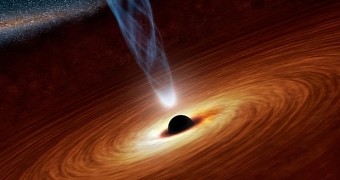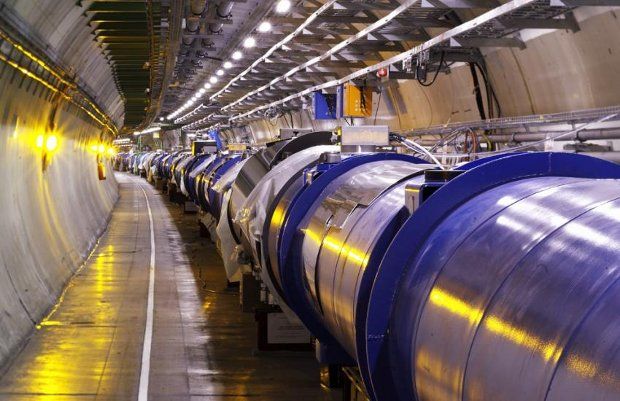In just a few days, the Large Hadron Collider (LHC), essentially a mammoth particle smasher operated by the European Organization for Nuclear Research (CERN), will once again be back in action.
In 2012, the LHC made it possible for scientists to zoom in on the elusive Higgs boson, sometimes referred to as God's particle, which gives all other fundamental particles in the universe mass.
The following year, the massive installation, buried in the ground close to Geneva, Switzerland, was put in time-out while brainiacs got to work upgrading it and doubling the energy levels it can reach.
Thus, the collisions the LHC will produce during its upcoming second round of operations are expected to happen at energy levels two times greater than the ones that led to the discovery of the Higgs boson.
When they fire up the installation later this month, researchers will be on the lookout for potential signs of dark matter, which neither emits nor absorbs light and is only known via its effects on visible matter.
They will also try to learn more about the Higgs boson. Yup, much is expected from this second round of experiments at the LHC. Heck, scientists must be biting their nails in anticipation right about now.
As if the CERN brainiacs operating the LHC didn't already have enough on their mind, a new paper in the journal Physics Letters B theorizes that the installation could also find alternate realities.
That's right, word has it that the LHC could be used to prove the existence of parallel universes in extra dimensions. It all sounds kind of surreal, but scientists seem convinced that this is indeed the case.
How the LHC could reveal alternate realities
It’s safe to assume that nobody wants to feel their brain overload and their neurons wriggling in pain inside their skull, so let's take it from the top and see what we can make of this whole parallel universes talk.
Physicists Ahmed Farag Ali, Mir Faizal, and Mohammed M. Khalil say that, to reveal the existence of alternate realities, the LHC would simply have to zoom in on miniature black holes. Already too much?
Well then, let's slow it down a bit. As explained by scientists, black holes are basically regions whose gravitational pull is so great that nothing can escape them, not even light.
Mind you, black holes are not empty space. Instead, they comprise huge amounts of matter that is mind-bogglingly compact. Kind of like having 10 Suns packed into a sphere the size of NYC.
Cosmic black holes form when stars die, leaving behind a dense core. At the LHC, collisions could lead to the creation of infinitesimal black holes that would be kind of, sort of like particles governed by gravity.
It was previously said that, to form such black holes, the LHC would have to produce collisions at energy levels far greater (we're talking like a gazillion times more powerful) than it can handle.
Ahmed Farag Ali, Mir Faizal, and Mohammed M. Khalil disagree and say that, if other dimensions exist and gravity can leak from our universe into them, as proposed by new theoretical models, then mini black holes can be produced at the LHC.
The other way around, the detection of miniature black holes would prove leaks of gravity, which would in turn prove the existence of other dimension, the physicists go on to explain.
“We predict that gravity can leak into extra dimensions, and if it does, then miniature black holes can be produced at the LHC,” specialist Mir Faizal with the University of Waterloo said in a statement, as cited by Phys Org.
By extension, these other dimensions whose existence would be proven by the detection of microscopic black holes at the LHC would be an indicator of parallel universes. Pretty cool, right?
“What we mean is real universes in extra dimensions. As gravity can flow out of our universe into the extra dimensions, such a model can be tested by the detection of mini black holes at the LHC,” said Mir Faizal.
What the heck goes on inside the LHC anyway?
As mentioned, the LHC is the world's largest particle smasher. No, the installation doesn't just grab particles and whack them over the head with Thor's hammer or anything of the sorts.
What it does is use magnets to accelerate beams of protons to a speed pretty darn close to that of light and then get them to collide with one another. As a result, the protons are broken apart.
From the resulting debris and under the influence of the energy released by the blast, new particles are born. Well, new as in previously inexistent in the installation, not as in never-before-seen in the universe.
The LHC is buried about 100 meters (328 feet) in the underground and is shaped like a circular pipe whose circumference is one of 27 kilometers (approximately 16.8 miles).
Whatever new particles form after the beams of protons collide with one another are documented with the help of sophisticated instruments best described as hypersensitive microscopes.

 14 DAY TRIAL //
14 DAY TRIAL // 

